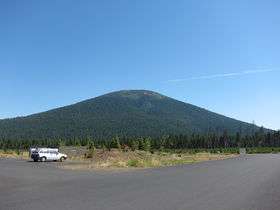Black Butte (Oregon)
| Black Butte | |
|---|---|
 | |
| Highest point | |
| Elevation | 6,436 ft (1,962 m) NAVD 88[1] |
| Prominence | 3,076 ft (938 m) [2] |
| Coordinates | 44°23′59″N 121°38′08″W / 44.399724139°N 121.635477517°WCoordinates: 44°23′59″N 121°38′08″W / 44.399724139°N 121.635477517°W [1] |
| Geography | |
| Location | Jefferson County, Oregon, U.S. |
| Parent range | Cascade Range |
| Topo map | USGS Black Butte |
| Geology | |
| Age of rock | Pleistocene |
| Mountain type | Mafic volcano[3] |
| Volcanic arc | Cascade Volcanic Arc |
| Last eruption | About 1,430,000 years ago[4] |
| Climbing | |
| Easiest route | Hike |

Black Butte is a stratovolcano (not a cinder cone) 5.5 miles (8.9 km) west of Sisters, Oregon in Deschutes National Forest.
Black Butte looks young, as it is barely eroded (except for little gullies a little bit above the base that were carved by long-gone streams). Mount Washington, which is visible from the summit of Black Butte, looks much more eroded, and older, than Black Butte. However, Black Butte is significantly older than Mount Washington which was eroded by glaciers, but Black Butte is east of the Cascade crest and does not receive enough precipitation to support glaciers, so erosion is minimal.[5]
It is an extinct volcano composed of basaltic andesite. The cone rises 3,076 feet (938 m) over the surrounding plateau. Black Butte is a striking feature just north of US Highway 20, which descends from the east flank of the Cascades. It is nearly symmetrical,[6] with no marks of glaciation. Even though it is older than the High Cascades mountains visible to the west, which are heavily scoured by ice-age glacier activity, Black Butte receives less snow at its lower elevation and location east of the High Cascades. The headwaters of the Metolius River flow from Metolius Springs near the northern base of Black Butte.[6] The spring flows at a consistent rate of 45,000 to 50,000 US gallons (170 to 190 m3) per minute.[7]
In the local indigenous tongue, the mountain is called Turututu, but records show settlers calling it Black Butte as early as 1855.[6]
Forest Service road 1110 climbs halfway up the mountain and a hiking trail continues to the summit.[8] At the summit, there are two fire lookout towers. Black Butte Cupola was built in in 1924 and decommissioned in 1979. An 85-foot tower built in 1934, collapsed in 2001.[9] Another tower was constructed in 1995 to replace the older one.[10]

See also
References
- 1 2 "Black Butte". NGS data sheet. U.S. National Geodetic Survey. Retrieved 2008-03-31.
- ↑ "Black Butte, Oregon". Peakbagger.com. Retrieved 2008-03-31.
- ↑ "Learn About Volcanoes". Cascades Volcano Observatory. US Geological Survey. Retrieved 2008-11-18.
- ↑ "Geologic Map of the Bend 30×60-Minute Quadrangle, Central Oregon" (PDF). US Geological Survey. p. 22. Retrieved 2008-03-31.
- ↑ "Black Butte". Global Volcanism Program. Smithsonian Institution. Retrieved 13 September 2016.
- 1 2 3 McArthur, Lewis A.; Lewis L. McArthur (1984) [1928]. Oregon Geographic Names (6th ed.). Portland, Oregon: Oregon Historical Society Press. p. 74. ISBN 0-87595-237-2.
- ↑ Peterson, N.V.; R.A. Groh (March 1972). "Geology and Origin of the Metolius Springs" (PDF). The Orr Bin. Portland, Oregon: State of Oregon Department of Geology and Mineral Industries. 34 (3). Retrieved 2008-03-31.
- ↑ "Black Butte Trail". USDA Forest Service. Retrieved 2013-06-10.
- ↑ "Black Butte in Deschutes National Forest". hikespeak.com. hikespeak.com. Retrieved 2016-11-19.
- ↑ "Black Butte Lookout". CoolTrails.com. Retrieved 2008-11-08.
External links
| Wikimedia Commons has media related to Black Butte Peak, Oregon. |